Cover Story
Myanmar’s airline industry tested by rapid growth
May 1st 2014
STAMPEDE
Little more than two years ago, Myanmar was one of the region’s forgotten aviation markets. Decades of isolation, under a repressive political regime, had excluded the resources rich country from the region’s airline boom, but no longer, as Tom Ballantyne reports. Read More »
Myanmar, opened to the world in 2012 after more than forty years of political and economic isolation, is the Asia-Pacific growth flavor of the decade for the airline industry. Foreign carriers have poured into a country rich in both resources and population.
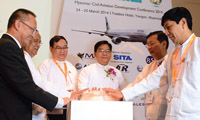 |
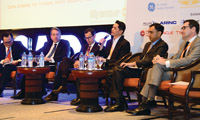 |
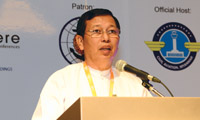 |
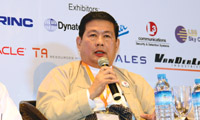 |
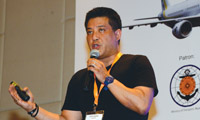 |
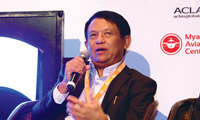 |
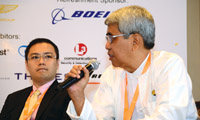 |
The country has recorded one of the highest passenger growth rates in the region in the last 30 months, but airlines serving Myanmar face the daunting challenges of inadequate infrastructure, over-capacity and an awful lot of red ink.
Yet Myanmar’s aviation leaders are determined to resolve their multi-billion dollar problems and secure their share of the domestic and regional airline market.
“For the future of Myanmar’s aviation sector, we have set a vision that aims to make Myanmar a major aviation hub in Asia,” said the country’s Minister of Transport, Nyan Htun Aung, at the recent inaugural Myanmar Civil Aviation Development Conference 2014 in Yangon.
Myanmar had developed a four point strategy to achieve its goal: liberalizing economic regulation, establishing new air links to international destinations, promoting national airlines and improving infrastructure, he said.
No one is pretending it will be easy, or even possible, for Mr Nyan’s government to succeed. Its infrastructure, particularly airport capacity, is already struggling to cope with rocketing demand as tourists and name card bearing business people alike fan out in a country of 65 million people that it is perceived to have limitless economic potential.
Total passenger traffic to Myanmar numbered 6.5 million last year, a 16.5% increase over 2012. Twenty-eight international airlines now operate into the country, eight of them low-cost carriers, compared with just 12 in 2009.
Such rapid airline expansion is putting tremendous competitive pressure on the eight local carriers (four more have submitted applications to launch) to win customers and keep afloat financially. Only one Myanmar airline, Myanmar Airways International (MAI), has enough passengers to be counted in the top ten, with just under a 10% international market share. The airline is now fully owned by the Kanbawza Bank Ltd of Myanmar.
According to statistics from consultancy Innovata, Myanmar’s domestic traffic has grown by 30% since 2004, but international traffic has leapt by 420% in the same period.
Most of the other Myanmar carriers, government-owned Myanma Airways, Yangon Airways, Air Mandalay, Asian Wings Airways, Air Bagan, Air KBZ and budget carrier, Golden Myanmar Airlines, are small and many of them are struggling. As U Si Thu, managing director of MAI told conference delegates, “only the fittest will survive in this environment”.
He said airlines [in Myanmar] should be listed as “an endangered species”. He said the competition and the “unstoppable expansion’ of the region’s low-cost carriers and the influx of better capitalized full service airlines to Myanmar were “daunting”.
It is a view shared by many analysts who say there definite signs too many airlines are entering the Myanmar market at the same time and that the number of airlines could decline through either mergers or financial failure.
Andrew Herdman, the director general of the Association of Asia-Pacific Airlines (AAPA), underscored the fragility of the country’s airline business when he said Myanmar was “an interesting version of a new market, where you have more players than seats”. “Growth does not necessarily translate into profits,” he added.
Competition isn’t the only problem. Airports are antiquated and only three of the country’s 33 facilities - Yangon (Rangoon), Mandalay and Naypyitaw - meet international standards. Others have runways that are too short, are not equipped with advanced navigation and safety equipment and have understaffed security systems. Yangon, the country’s busiest airport, has surpassed its annual capacity of 2.7 million passengers, hitting 3.7 million last year.
Among other issues that need to be addressed, are recruitment and training of cockpit and technical staff, investment in air traffic management, a reduction in local taxes on the already high price of aviation kerosene, safety and widespread institutionalized corruption.
Of the country’s tiny fleet of domestic commercial aircraft, mostly Chinese-built Xian MA60 turboprops, four were involved in serious accidents in 2012 and two more last year. The deputy director of the Myanmar’s Department of Civil Aviation (DGA), Win Swe Tun, said the country’s air safety accident rate was nine times higher than the global average.
|
Myanmar international airlines
passenger growth: 2010 to 2013 2010: 1.2 million 2011: 1.5 million 2012: 2.0 million 2013: 2.7 million Yangon International Airport annual passenger traffic: 2008 to 2013 2008: 1.5 million 2009: 1.6 million 2010: 2.0 million 2011: 2.5 million 2012: 3.1 million 2013: 3.7 million Source: Department of Civil Aviation Myanmar 2013 |
Much of this can be blamed on the country’s long years of isolation. Yangon, then Rangoon, was a major Southeast Asian hub in the 1950s, but after the military seized power in 1962, civilian aviation entered a long decline.
International isolation made it hard for airlines to deal directly with manufacturers, import equipment, train staff or finance infrastructure. Some of those problems were alleviated when the European Union removed its sanctions. The U.S. has suspended sanctions, but not removed them unilaterally. The good news is that Myanmar aviation authorities are well aware of the issues and what needs to be done.
The country’s director general of the DCA, Tin Naing Tun, said in March that his ministry would manage growth by first concluding air services agreements with new bilateral partners and then revising old agreements by inserting more liberal provisions in them.
“We have linked to some emerging economies like India, China and Japan. In the foreseeable future, we will expand our air route networks to access worldwide destinations, especially to Europe, the U.S. and Australia,” he said.
“We will upgrade, in a timely manner, our air transport infrastructure. We recognize the importance of aviation safety and capacity building for the development of our aviation sector,” he explained.
To speed up development, the ministry is launching a public-private partnership scheme. “We have started a public-private partnership for international airports and recently taken further steps to do the same for domestic airports. These steps are supported by our new foreign investment law, which allows foreign investment in 20 air transport service sectors, including airports and air carriers,” Tin said.
Myanmar’s airlines which operate international routes include MAI’s services to Cambodia, China, Japan, Malaysia, Singapore, South Korea and Thailand. It has codeshare arrangements with Jetstar Asia, Asiana Airlines, Korean Air, Thai Airways International and Malaysia Airlines. It has a fleet of nine: four A319-100s and five A320-200s, of which one is the country’s presidential jet. Budget carrier, Golden Myanmar Airlines, established in 2013, flies to Singapore and Bangkok operating two A320s. All Nippon Airways bought a 49% holding in Asian Wings Airline, a three-year-old carrier with ambitions to operate as a regional carrier.
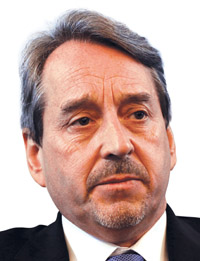 |
| 'Myanmar is an interesting version of a new market, where you have more players than seats' |
| Andrew Herdman Director General, Association of Asia-Pacific Airlines |
They will be joined by the government’s own carrier, Myanma Air, which has announced its fleet expansion plan. In February, it said it would lease six B737-800s and four B737-8Max from GECAS, with the aircraft to be delivered through to 2020. The order was the largest single fleet order in the country’s history and will give the carrier the flexibility and capacity to spread its wings overseas.
Nevertheless, local carriers face tough competition from seasoned regional rivals and beyond. Foreign carriers flying into Myanmar include Singapore Airlines, Silk Air, Thai Airways International, Malaysia Airlines, Air China, China Southern and China Eastern Airlines, All Nippon Airways, Qatar Airways, Korean Air, EVA Air, Vietnam Airlines and Dragonair.
A joint venture between Japan Airlines and Mitsubishi Logistics has launched cargo flights to Myanmar and German charter operator, Condor, operates a weekly service from Frankfurt.
The foreign invasion is likely to increase. Many Western carriers are holding back from flying there until their governments “clarify” issues on Myanmar’s human rights record. They are also waiting for the implementation of relevant international agreements in the field of non-proliferation and disarmament. When these political issues are resolved, it is predicted more airlines, particularly from Europe and the U.S., will launch services to Myanmar.
Last August, a consortium led by South Korea’s Incheon International Airport Corporation was selected as the preferred bidder to develop the Hathawaddy International Airport, to be built about 95 kilometers from Yangon. It is planned for an initial capacity of 12 million passengers annually, growing to 30 million by 2030. However, talks collapsed over funding. A new consortium, including Singapore’s Changi Airport and Japan’s Yongnam Holdings, has been invited to re-enter negotiations to build and operate the new Yangon facility, which is expected to cost about $1.5 billion.
These changes mean the new airport is unlikely to be ready by the scheduled completion date of 2018. The government also has asked private companies to bid on operating 30 domestic airports, and invited tenders to expand and operate the existing Yangon and Mandalay airports.
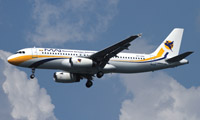 |
Interest in getting a foot in the Myanmar door was clearly shown at the March conference, which was attended by more than 250 airport operators, regulators, senior airlines executives and key aviation stakeholders from some 20 countries. And the interest is not just talk.Some serious investment in the aviation sector is underway.
All Nippon Airways (ANA), which restarted flights to Myanmar in 2013, after a 12-year hiatus, is buying a $25 million, 49% stake in Asian Wings, an investment seen by rivals as a foothold in the fast growing Asean (Association of South East Asian Nations) market, which is scheduled to introduce full open skies next year.
“There’s still a lot more room for growth in travel in Asia,” said Toshiaki Nonaka, a director of strategic planning at ANA. “We want to actively go and seize that growth. With this tie-up, we’re expanding our base for flights to other Asian countries.” Japan has been the fastest growing market for Yangon, increasing nearly 300% year-on-year. ANA has moved from three flights a week to Yangon out of Narita Airport to daily services.
Asian Wings, based in Yangon, started flying in 2011 and operates three ATR72 turboprops and one A320. Currently flying only domestically it plans to launch international services. It will add 10 A320s to its fleet by 2019, and boost its ATR aircraft to four, more than tripling its fleet to 15 planes, according to Nonaka. ANA is considering leasing the Airbus planes to Asian Wings and may invest in new ticketing technology at the airline.
VietJet Aviation Joint Stock Company, Vietnam’s only privately owned airline, is in talks with an unidentified local carrier and Thai AirAsia has entered into joint venture talks with “some potential partners,” said Tassapon Bijleveld, chief executive of the Thai subsidiary of Malaysia’s AirAsia Group.
| 'Japan has been the fastest growing market for Yangon, increasing nearly 300% year-on-year' |
| Toshiaki Nonaka Director of strategic planning All Nippon Airways |
Tourism is regarded as the key to Myanmar’s prosperity, but the government is dealing with another issue: where will those increasing numbers of visitors stay? This year, authorities have cleared 166 new hotel projects, with more than 7,800 rooms, at major tourist destinations to cater for the increase in tourism. And according to analysts this will not be enough to cope with demand.
The minister of Transport, Nyan Htun Aung, remains confident the hurdles to aviation operations and prosperity will be overcome.
“We have defined a mission that will drive us to develop and strengthen the safe, secure, efficient, sustainable and environmentally friendly aviation industry in the country. From the regulatory perspective, air transport liberalization has been carried out both in the ASEAN context as well as in bilateral relations in line with international trends,” he said.
“Such regulatory reforms in the aviation sector, together with our restructured investment laws, offer opportunities for both domestic and foreign private participation in the sustainable development of aviation in Myanmar.”
Dmitri Kozlov says:
November 23rd 2017 06:37pm